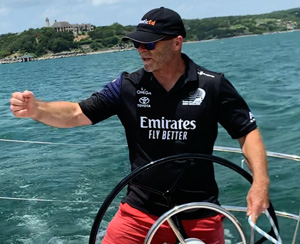NauticEd Navigator gives you personalized
course recommendations based on your
sailing goals and experience
Chart a Course to Your Sailing Future
 Select my goals
Select my goals NauticEd Navigator gives you personalized
course recommendations based on your
sailing goals and experience
 Select my goals
Select my goals
Learn the art of dinghy sailing with our interactive online course! Join Finn and Anna as they guide you through the essentials in a fun and engaging way. Whether you're new to sailing or looking to brush up on your skills, this course covers everything you need to know to start safely sailing a dinghy.
Estimated Time: 3 hours
Price: $9.99
Enroll in the Getting Started in Dinghy Sailing online course and learn all the basics of how to safely sail a dinghy. Join Finn and Anna as they teach you the essentials of dinghy sailing in an interactive and engaging way.
Originally created in the Netherlands to teach dinghy sailing to summer camp kids, this course has been expanded with more content, images, and interactive animations to help you learn the fundamentals of dinghy sailing. Whether you are a beginner or an experienced sailor, The Getting Started in Dinghy Sailing course teaches all of the basics of how to safely sail a dinghy.
So come join Finn and Anna, have fun with the interactive course, and take the first step towards mastering the art of dinghy sailing!

By Grant Headifen
NauticEd Global Director of Education
View Getting Started in Dinghy Sailing Course excerpt
I love teaching about sailing angles to the wind. Some people call it “the points of sail” but I just call it the sailing angles to the wind. At first, it seems a wee bit tricky; but it’s actually pretty simple.
When you are sailing, you are always sailing at an angle to the wind. Each angle has a name. You will need to learn these names so that you can properly communicate with other sailors. Hover over each letter next to a boat below to learn the name of each angle.
O Into-The-Wind; also called Dead-To-Wind and Head-To-Wind
A sailboat cannot sail directly into the wind. If you try, the sails will just flap wildly. The boat will stop and will even be blown backward. You can sail in all directions, except directly into the wind.
A and K: Close-Haul
A “close-haul” sailing angle is as close to the direction where the wind comes from as you can sail. At this wind angle, you will need to make sure your sails are pulled in tight and the daggerboard/centerboard is all the way down. The boom should be pulled into a position so that the line of the boom points to the aft corner of the boat.
You typically sail at this angle to the wind if you are trying to sail to a place that is up-wind. To get to this place you will need to sail pointing in direction A, then switch over and point in the direction K. Then, you repeat and repeat this until you get to your upwind destination. You’ll learn later that this switch from A to K is called tacking. As you sail on angle A or K, you have to watch the sails closely. If they become loose, it means you are sailing too much up into the wind and so you will need to make a tiny adjustment to bear away from the wind to fill the sails again. Keep watching. Over time you’ll get good enough to feel the boat change if it is pointed too much up into the wind. You’ll learn about this more in the section of this course called sail-trim.
Below, Finn is on a close-haul on-port. Why on-port? Because the wind is coming from the port side of the boat (you can see this because the sails are blown over to the starboard side).
B and J: Close-Reach
A close-reach sailing angle is when you are sailing a little bit upwind but also across the wind. Your sails will be let out just a little bit more than when compared to the A and K “close haul” sailing angle. Your boat will go pretty fast at this angle to the wind.
Below, I am on a close-reach on-port.
C and I: Beam-Reach:
A boat on a beam-reach means it is cutting exactly across the wind. The wind hits directly on the side of the boat hull. The boat moves through the water the fastest at this angle. The boat does not heel over as much as a close-haul or close reach because the sails are let out. Look at this this in the image below. To go even faster and to make steering easier, you can even pull the daggerboard halfway up.
I really appreciate your website and services. Living on the East Coast the winter gets really looooong. Having a site like yours to work on is a great way to stay tuned into sailing and to improve your skills.